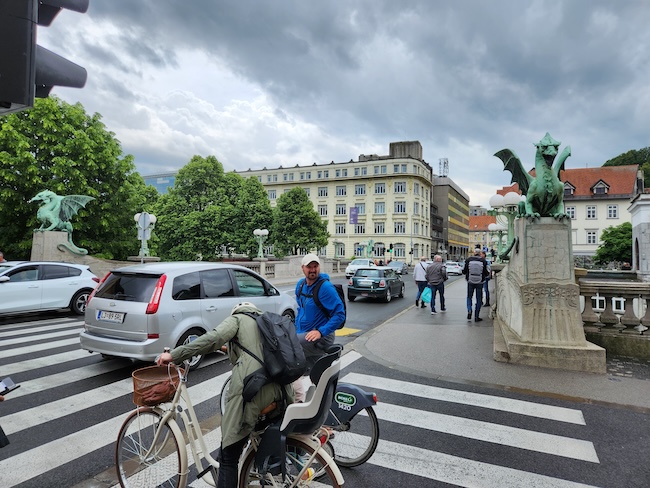Ljubljana - Page 2
By Tom Kagy | 15 Jul, 2025
The fourth stay of our 12-day Central Europe road trip, Slovenia's charming capital, exceeded our expectations in every respect.
In Ljubljana we crossed and re-crossed little Ljubljanica River a dozen times on its assortment of charming little bridges to wander among restaurants, shops, the castle, farmer's market and boat cruise docks without killing ourselves. After looping central Ljubljana the little Ljubljanica, born in the foothills of the Alps to the west, ultimately joins the Sava River which in turn joins the Danube which flows all the way to the Black Sea between Ukraine and Moldova.
The Ljubljana Farmer's Market near Dragon Bridge offers clothing, local rocks and souvenirs as well as fresh produce.
On that first evening we were hungry. We walked to the right of the Triple Bridge down the riverwalk following the Ljubljanica's southward bend. Three hundred yards from Triple Bridge, past the elegantly modern Ribja brv (Ribja Bridge), we crossed Šuštarski most (Cobbler's Bridge) to the other side. About seventy yards south of the bridge we ventured into a short alley and found the understated but elegant Julija restaurant which had apparently won a Michelin Star in the recent past.
The heart of Ljubljana is Preserven Square, named after the poet memorialized by a statue, along with his muse. In the background is the magnificent pink baroque Franciscan Church of the Annunciation.
The indoor tables were filled so we took an outdoor table near two tables of English tourists. For entrees we ordered prawn scampi and fuzi pasta — which turned out to be exquisitely seasoned — prosecco, and an apple strudel with ice cream. The tab was about 75% of what we might pay at comparable restaurants in California tourist towns like Montecito, Avila Beach or Atascadero, and similar to what we had been paying at Prague, Bratislava and Budapest. Julija's portions were smaller than we had come to expect in Central European restaurants but just right for our healthy appetites.
The Ljubljanica riverwalk offers a view of the castle atop a hill at the center of the city.
DAY TWO
After a perfectly adequate and nutritious uHotel breakfast buffet we set out on our first full day in Ljubljana with the modest aim of leisurely exploring a very pedestrian-friendly city. With the goal of approaching Dragon Bridge (Zmajski most) from the north as generally contemplated by tourist guides, upon reaching the end of our hotel driveway we turned left to walk north on Miklosiceva cesta (Road), away from Preseren Square, then a right on Dalmatinova ulica (Street), left on Mala ulica, right on Komenskega ulica, and finally right on Resljeva cesta toward Dragon Bridge which became visible after a block.
A green bronze sculpture of a ferocious dragon greeted us from granite pedestals on each sides of the bridge. The mid-sections of the bridge were also decorated by smaller bronze figures of griffins serving to hold up lamps. The motif plays up Ljubljana's "City of Dragons" self-styling which derives from the Greek legend of Jason sailing with his argonauts up the Danube, the Sava, and finally, the Ljubljanica, after stealing the golden fleece. He then the doughty Jason slayed a dragon at a lake near the source of the Ljubljanica on his way back home to Greece. The city even has a dragon mascot named Ljubo, and its castle has a 500-year-old chapel dedicated to St. George, the slayer of dragons.
Our somewhat anticlimactic crossing of Dragon Bridge, all 60 yards of it, was in the company of a fair number of obvious tourists albeit an order of magnitude fewer than on Prague's swarming Charles Bridge. On the other side we devoted a few minutes to the inevitable photo op before turning right to head back west in the direction of Preseren Square. Almost immediately to our left was the city's Central Market, a farmer's market with various other wares. We bought some pretty blue stones from a friendly man at a small stand. We then spotted a large souvenir shop adjacent to the big market square and spent a half hour picking out memorabilia.
The market opened out to a street, the only one, running parallel to the river and wrapping counter-clockwise around the lush green hill on which stands Ljubljanski grad (Ljubljana Castle). After strolling a few hundred yards our attention was drawn to the purposeful strides of a group of people turning left into an alley that appeared to grade upward toward the hill. We followed them up a surprisingly long looping, and at times steep, path that ended up on the back side of the castle.
The prospect of spending a half hour inspecting the interior of Ljubljana Castle didn't appeal to us as much as exploring its lush hilly grounds which includes an overland foot bridge leading to a parking lot at the front entrance, an old-fashioned water mill next to it, and a platform affording a view of the area.
For us the hill jaunt was a pleasant nature interlude in the shadow of a castle that has been massively renovated about four times over the thousand years since it was originally built in the 11th Century. Today it serves as a city cultural venue. Rather than entering to see preservation of dead culture, we were eager to get back down to experience more of Ljubljana's living culture, made more vibrant and youthful by the city's 11 colleges and universities, a huge number for a city of only about 300,000, or about a seventh of Slovenia's 2 million inhabitants.
For us the hill jaunt was a pleasant nature interlude in the shadow of a castle that has been massively renovated about four times over the thousand years since it was originally built in the 11th Century.

One of Ljubljana's designated tourist attractions is Dragon Bridge which symbolizes the city's role in the Greek legend of Jason and the Golden Fleece.
Asian American Success Stories
- The 130 Most Inspiring Asian Americans of All Time
- 12 Most Brilliant Asian Americans
- Greatest Asian American War Heroes
- Asian American Digital Pioneers
- New Asian American Imagemakers
- Asian American Innovators
- The 20 Most Inspiring Asian Sports Stars
- 5 Most Daring Asian Americans
- Surprising Superstars
- TV’s Hottest Asians
- 100 Greatest Asian American Entrepreneurs
- Asian American Wonder Women
- Greatest Asian American Rags-to-Riches Stories
- Notable Asian American Professionals

